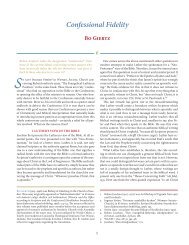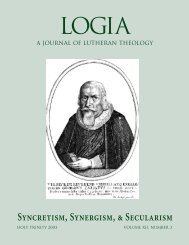The Lord's Supper in the Theology of Martin Chemnitz Bjarne - Logia
The Lord's Supper in the Theology of Martin Chemnitz Bjarne - Logia
The Lord's Supper in the Theology of Martin Chemnitz Bjarne - Logia
Create successful ePaper yourself
Turn your PDF publications into a flip-book with our unique Google optimized e-Paper software.
<strong>The</strong> Consecration | 0<br />
253 This doctr<strong>in</strong>e found expression not only <strong>in</strong> <strong>the</strong> writ<strong>in</strong>gs <strong>of</strong> <strong>the</strong> Reformation<br />
<strong>the</strong>ologians but also <strong>in</strong> <strong>the</strong> rubrics <strong>of</strong> <strong>the</strong> early Lu<strong>the</strong>ran liturgies<br />
(see note 32). And it has cont<strong>in</strong>ued to be taught and proclaimed<br />
<strong>in</strong> song by some later Lu<strong>the</strong>rans. 67 Many o<strong>the</strong>rs, however, <strong>in</strong> follow<strong>in</strong>g<br />
Melanchthon, have denied <strong>the</strong> fact that <strong>in</strong> a legitimate observance<br />
<strong>of</strong> <strong>the</strong> Lord’s <strong>Supper</strong> one knows when <strong>the</strong> sacramental presence beg<strong>in</strong>s.<br />
This is virtually to deny <strong>the</strong> words <strong>of</strong> Christ and make <strong>the</strong>m<br />
conditional on someth<strong>in</strong>g o<strong>the</strong>r than His own words, <strong>the</strong>reby sett<strong>in</strong>g<br />
up a monstrum <strong>in</strong>certud<strong>in</strong>is with respect to <strong>the</strong> Real Presence and <strong>the</strong><br />
benefits <strong>of</strong> <strong>the</strong> sacrament.<br />
chemnitz and <strong>the</strong> veneration <strong>of</strong> <strong>the</strong> sacrament<br />
254 Before one considers how <strong>Chemnitz</strong> treats <strong>the</strong> controversial subject<br />
<strong>of</strong> <strong>the</strong> adoration <strong>of</strong> <strong>the</strong> sacrament, it is necessary that one has an exact<br />
understand<strong>in</strong>g <strong>of</strong> <strong>Chemnitz</strong>’s concept embodied <strong>in</strong> <strong>the</strong> terms “action”<br />
or “use” when applied to <strong>the</strong> Lord’s <strong>Supper</strong>. S<strong>in</strong>ce <strong>the</strong>se terms have<br />
already been exam<strong>in</strong>ed (see pp. 11–14) <strong>the</strong> ma<strong>in</strong> po<strong>in</strong>ts will only be<br />
briefly summarized here. <strong>The</strong> Verba show that <strong>the</strong> sacramental action<br />
encompasses <strong>the</strong> consecration <strong>of</strong> particular elements, <strong>the</strong>ir distribution<br />
and consumption (Ex. 2, 249; SD VII, 84–87). <strong>The</strong> consecration<br />
is that part <strong>of</strong> <strong>the</strong> action that effects <strong>the</strong> presence <strong>of</strong> <strong>the</strong> body and blood<br />
<strong>of</strong> Christ. This means that Jesus Christ, true God and Man <strong>in</strong> one person<br />
has been sacramentally united with <strong>the</strong>se particular elements just<br />
as <strong>the</strong> Apology had said years before, “We are talk<strong>in</strong>g about <strong>the</strong> presence<br />
<strong>of</strong> <strong>the</strong> liv<strong>in</strong>g Christ, know<strong>in</strong>g that death no longer has dom<strong>in</strong>ion<br />
over him” (Ap. X, 4). <strong>The</strong> body rema<strong>in</strong>s <strong>in</strong> <strong>the</strong> personal union as part<br />
<strong>of</strong> <strong>the</strong> God-Man, so that <strong>Chemnitz</strong> warns us to “be on guard” that<br />
<strong>the</strong> personal union is not dissolved because <strong>of</strong> mention<strong>in</strong>g <strong>the</strong> natural<br />
properties (TNC 443). Before <strong>the</strong> consecration, however, Christ is<br />
not present <strong>in</strong> <strong>the</strong> def<strong>in</strong>itive mode (LS 156). But after <strong>the</strong> consecration<br />
<strong>the</strong> body and blood <strong>of</strong> Christ are present <strong>in</strong> this special mode. <strong>The</strong><br />
“action” <strong>of</strong> <strong>the</strong> Lord’s <strong>Supper</strong> is not merely an action <strong>in</strong> our modern<br />
sense <strong>of</strong> “<strong>the</strong> do<strong>in</strong>g <strong>of</strong> someth<strong>in</strong>g.” It <strong>in</strong>cludes <strong>the</strong> “th<strong>in</strong>g” and <strong>the</strong> do<strong>in</strong>g<br />
<strong>of</strong> someth<strong>in</strong>g with that “th<strong>in</strong>g.” <strong>Chemnitz</strong> states that “<strong>the</strong> very name<br />
and def<strong>in</strong>ition <strong>of</strong> a sacrament embraces <strong>the</strong> presence <strong>of</strong> some visible and<br />
external element to which <strong>the</strong> Word must come and <strong>in</strong>cludes this, that<br />
<strong>the</strong> whole action is performed and adm<strong>in</strong>istered <strong>in</strong> a certa<strong>in</strong> way with a<br />
specific div<strong>in</strong>ely <strong>in</strong>stituted ceremony” (Ex. 2, 109 f.; emphasis added).




